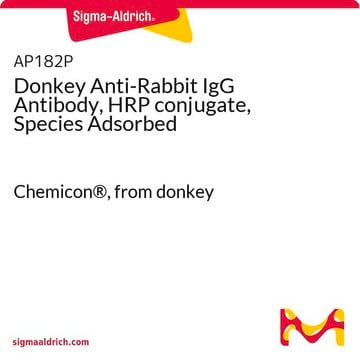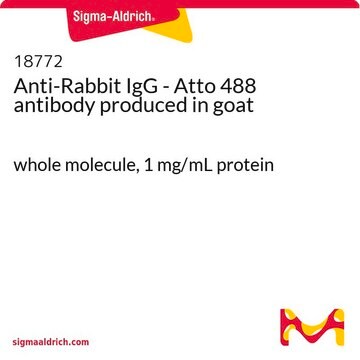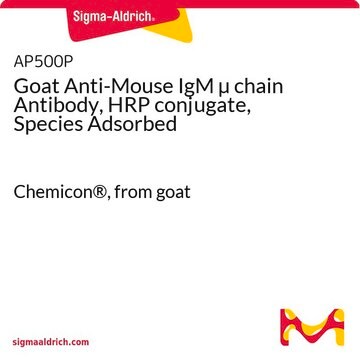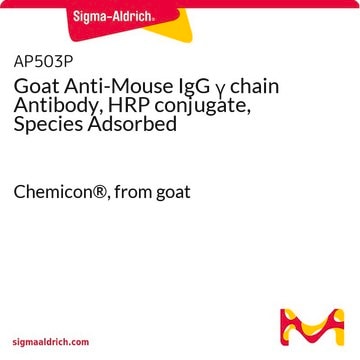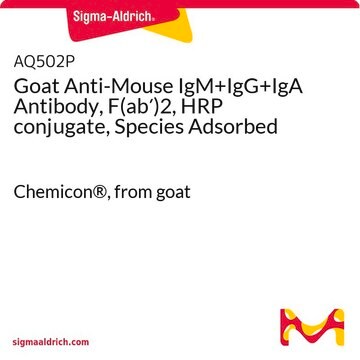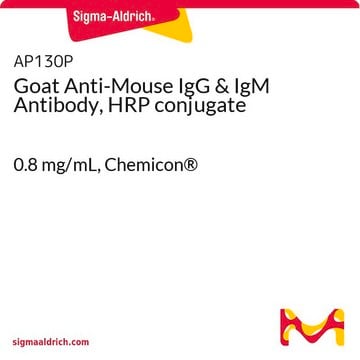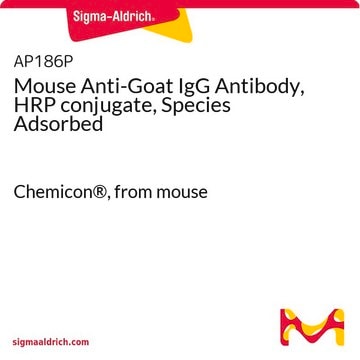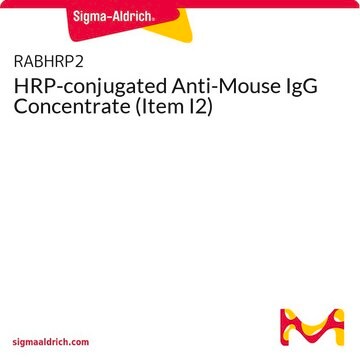AP192P
Donkey Anti-Mouse IgG Antibody, HRP conjugate, Species Adsorbed
Chemicon®, from donkey
Synonym(s):
Anti-Mouse antibody, Donkey anti-Mouse IgG
Sign Into View Organizational & Contract Pricing
All Photos(1)
About This Item
UNSPSC Code:
12352203
eCl@ss:
32160702
NACRES:
NA.46
Recommended Products
biological source
donkey
Quality Level
conjugate
peroxidase conjugate
antibody form
affinity purified immunoglobulin
antibody product type
secondary antibodies
clone
polyclonal
species reactivity
mouse
manufacturer/tradename
Chemicon®
technique(s)
ELISA: suitable
western blot: suitable
shipped in
wet ice
target post-translational modification
unmodified
Specificity
Specific for mouse IgG, heavy and light chain.
Application
Donkey anti-Mouse IgG Antibody, HRP conjugate, Species Adsorbed is an antibody against Donkey Mouse IgG for use in ELISA & WB.
EIA and Western blots: 1:5,000-1:100,000.
Immunohistochemistry: 1:500-1:5,000.
Optimal working dilutions must be determined by end user.
Immunohistochemistry: 1:500-1:5,000.
Optimal working dilutions must be determined by end user.
Research Category
Secondary & Control Antibodies
Secondary & Control Antibodies
Research Sub Category
Secondary Antibodies Adsorbed for Dual Labeling
Secondary Antibodies Adsorbed for Dual Labeling
Physical form
Immunoaffinity Purified and Immunodepletion
Lyophilized. Buffer = 0.01 M Sodium Phosphate, 0.15M NaCl, pH 7.1 with 15 mg/mL BSA.
RECONSTITUTION:
Reconstitute with 500 μL of sterile distilled water.
RECONSTITUTION:
Reconstitute with 500 μL of sterile distilled water.
Storage and Stability
Maintain lyophilized product at 2–8°C for up to 12 months. After reconstitution the product is stable for several weeks at 2–8°C as an undiluted liquid. For extended storage after reconstitution, add an equal volume of glycerol to make a final concentration of 50% glycerol followed by storage at -20°C in undiluted aliquots for up to 12 months. Please note the concentration of protein (and buffer salts) will decrease to one-half of the original after the addition of glycerol. Avoid repeated freeze/thaw cycles.
WARNING:
Use of sodium azide as a preservative will substantially inhibit the enzyme activity of HRP.
WARNING:
Use of sodium azide as a preservative will substantially inhibit the enzyme activity of HRP.
Other Notes
Concentration: Please refer to the Certificate of Analysis for the lot-specific concentration.
Legal Information
CHEMICON is a registered trademark of Merck KGaA, Darmstadt, Germany
Disclaimer
Unless otherwise stated in our catalog or other company documentation accompanying the product(s), our products are intended for research use only and are not to be used for any other purpose, which includes but is not limited to, unauthorized commercial uses, in vitro diagnostic uses, ex vivo or in vivo therapeutic uses or any type of consumption or application to humans or animals.
Not finding the right product?
Try our Product Selector Tool.
Storage Class
11 - Combustible Solids
wgk_germany
WGK 3
Certificates of Analysis (COA)
Search for Certificates of Analysis (COA) by entering the products Lot/Batch Number. Lot and Batch Numbers can be found on a product’s label following the words ‘Lot’ or ‘Batch’.
Already Own This Product?
Find documentation for the products that you have recently purchased in the Document Library.
Customers Also Viewed
Dongmei Hu et al.
Biosensors, 3(3), 297-311 (2013-01-01)
Two label-free biosensor platforms, Resonance Waveguide Grating (RWG) and Surface Plasmon Resonance (SPR), were used to rank a large panel of anti-dengue virus NS1 antibodies. Dengue non-structural 1 (NS1) protein is an established serological marker for the early detection of
Hae-Young Park et al.
NPJ vaccines, 2, 31-31 (2017-12-22)
Targeting model antigens (Ags) to Clec9A on DC has been shown to induce, not only cytotoxic T cells, but also high levels of Ab. In fact, Ab responses against immunogenic Ag were effectively generated even in the absence of DC-activating
Decorin induces rapid secretion of thrombospondin-1 in basal breast carcinoma cells via inhibition of Ras homolog gene family, member A/Rho-associated coiled-coil containing protein kinase 1.
Neill, T; Jones, HR; Crane-Smith, Z; Owens, RT; Schaefer, L; Iozzo, RV
FEBS Journal null
Hiroyuki Honda et al.
Journal of neuropathology and experimental neurology, 75(11), 1008-1019 (2016-09-17)
Prion protein (PrP) has 2 glycosylated sites and a glycosylphosphatidylinositol (GPI) anchor on the C-terminal. Reports on genetic prion disease with GPI anchorless PrP are very limited. In this study, we characterized the molecular alterations of mutated PrP in a
Tianjiao Li et al.
Stem cell research & therapy, 10(1), 399-399 (2019-12-20)
Spermatogonial stem cells (SSCs) are the cornerstone of sperm production and thus perpetual male fertility. In clinics, transplantation of patient's own SSCs into testes is a promising technique to restore fertility when male germ cells have been depleted by gonadotoxic
Our team of scientists has experience in all areas of research including Life Science, Material Science, Chemical Synthesis, Chromatography, Analytical and many others.
Contact Technical Service